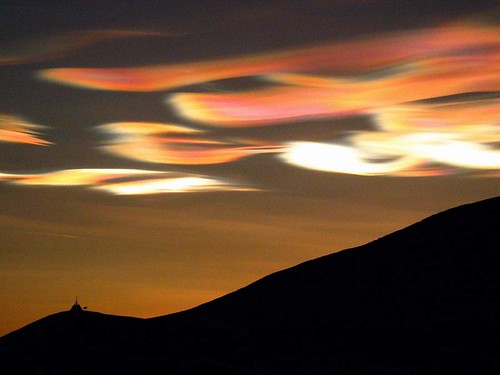
Nacreous clouds above McMurdo Station in Antarctica.
Image: Matt Thompson.
Nacreous means pearlescene or pearl-like, and these clouds are commonly referred to as "mother of pearl clouds".
These rare clouds form at altitudes of 15,000-25,000 meters (50,000-80,000 ft) above the earth's surface only when the sun is several degrees below the horizon, so other clouds at lower altitudes appear black. Their dazzling iridescent colors result from refraction of sunlight through tiny water-ice crystals that are carried by very strong, extremely cold winds in the stratosphere.
But because the stratosphere is very dry, nacreous clouds rarely form. Nacreous clouds are more common during the Antarctic winter and are thought to accompany ozone holes, although some types of nacreous cloud formations might also be more common after large volcanic eruptions that blast small particles into the stratosphere.
"They reveal extreme conditions in the atmosphere, and promote chemical changes that lead to destruction of vital stratospheric ozone," said Australian Antarctic Division scientist Andrew Klekociuk.
Additionally, because these rare, mother-of-pearl colored clouds are caused by extreme weather conditions above Antarctica, they are a possible indication of global warming.
Klekociuk said temperatures in the stratosphere, between 8 and 50 km (5-31 miles) above Earth, would be expected to drop as global warming increases. Data collected over the past 25 years had reflected this.
"Over that time there has been a small decrease in temperature, and that change is actually occurring faster than the warming at the surface of the earth," Klekociuk said. He explained that cooling of the stratosphere is predicted by scientists' models of global warming, "so it's quite possible the stratosphere is a good indicator of change happening lower down the atmosphere."
More information:
Reuters (quotes, some background).
ABC News online (quotes, some background).
.

like butterfly wing scales. nice.